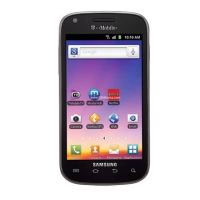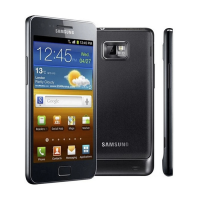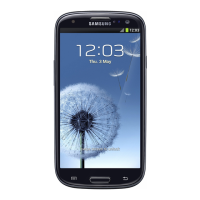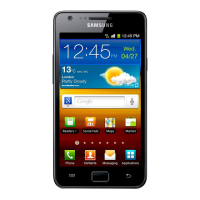Do you have a question about the Samsung Galaxy S 5 mini and is the answer not in the manual?
Product contains chemicals known to cause cancer, birth defects, or reproductive harm.
Outlines Samsung's ownership and user restrictions on intellectual property.
Excludes warranties and limits Samsung's liability for product use.
Details product warranty coverage and dispute resolution procedures.
Identifies and explains the function of external device components.
Identifies and explains the function of rear device components.
Guides through inserting SIM card and memory card.
Instructions on how to charge the device and when to do so.
Initial device setup steps, including powering on and security.
Guides on configuring Google and Samsung accounts on the device.
Instructions for setting up and accessing voicemail services.
Describes elements of the device's main screen and shortcuts.
Explains how to add shortcuts, widgets, and manage screens.
Details touchscreen navigation, motions, and gestures.
Explains how to view and manage notifications and quick settings.
Covers using the Samsung keyboard and predictive text.
Steps for initiating, receiving, and ending calls.
How to manage calls while using other device functions.
Managing call history, saving contacts, and deleting entries.
Instructions for making emergency calls with or without a SIM card.
How to access, uninstall, or disable applications.
Methods for organizing apps using folders and custom order.
Details on various Google apps like Chrome, Drive, Gmail, etc.
Information on specific carrier applications.
Describes additional preloaded apps like Dropbox and Kids Mode.
Step-by-step guide for performing calculations.
Explains clearing results and history.
Options for viewing the calendar by year, month, week, or day.
Steps to create, delete, and share calendar events.
Instructions for composing and capturing photos.
Configuration options for picture size, ISO, metering, etc.
Creating, setting, and managing alarms.
Tracking time in multiple cities and using the countdown timer.
Procedures for adding new contacts and modifying existing ones.
Searching for contacts and linking entries from various sources.
Organizing contacts into groups and marking favorites for quick access.
Steps to set up and add new email accounts.
Managing multiple accounts and removing unwanted ones.
Accessing and viewing images and videos.
Tools for editing photos and sharing them.
Using Tag Buddy and Face Tags for organizing photos.
Using command keys, tabs, bookmarks, and history.
Sharing pages and using secret mode for private browsing.
Creating, editing, deleting, and sending memos.
Step-by-step guide for composing and sending messages.
Viewing new messages, deleting, and searching messages.
Receiving and configuring emergency alert notifications.
Accessing and playing music files.
Viewing files organized by type and accessing storage.
Managing files, folders, and storage options.
Health considerations before starting a new exercise program.
How to activate and speak commands to S Voice.
Configuring S Voice preferences and options.
Description of the Galaxy Apps storefront.
Accessing curated premium content and applications.
Editing brightness, contrast, cropping, and rotating pictures.
Creating collages and editing video segments.
Understanding the player interface and controls.
Multitasking with video in a floating window.
Steps for creating recordings and choosing modes.
Displaying, searching, sharing, and deleting recordings.
Methods to open the Settings application.
Changing how settings are listed and customizing quick settings.
Turning Wi-Fi on/off and connecting to networks.
Configuring direct connections between devices.
Enabling and disabling Bluetooth functionality.
Establishing trusted connections with other devices.
Turning the hotspot on/off and connecting devices.
Steps to turn Airplane mode on or off.
Options for mobile data, limits, and usage cycles.
Enabling and managing location services and history.
Saving and managing favorite locations.
Selecting the primary app for messages.
Setting up and connecting to VPNs.
Transferring content like apps, images, and videos.
Selecting content, allowed devices, and download permissions.
Adjusting system volume and selecting sound profiles.
Setting vibration patterns, ringtones, and notification sounds.
Enabling or disabling notifications for specific apps.
Adjusting display brightness and text style.
Managing screen orientation and display duration.
Choosing display modes like Auto Adjust Screen Tone and Daydream.
Configuring swipe, pattern, PIN, and password lock details.
Choosing to show or hide notifications on the lock screen.
Rearranging quick setting buttons on the panel.
Steps to enable the Toolbox and choose up to five apps.
Steps to activate Easy Mode and switch back to Standard.
Options for visual impairments like TalkBack and font size.
Features for hearing impairments like flash notifications and subtitles.
Assistant menu, press/hold delay, and interaction control.
Steps to set up Private Mode, requiring a secure lock.
Enrolling and managing fingerprints for device access.
Changing backup passwords and additional scanner settings.
Explains direct call, smart alert, mute/pause, and palm swipe.
Steps to turn the Air View feature on.
Steps to add new accounts and sync data.
Configuring account preferences and removing accounts.
Managing sync settings and backups with Samsung account.
Using Dropbox for syncing and backup.
Enabling backups and automatic restoration to Google servers.
Resetting the device to factory defaults with protection.
Setting the default language for the device.
Using Samsung keyboard, predictive text, and other languages.
Configuring Swype themes, words, languages, and gestures.
Language, "Ok Google" detection, and speech output settings.
Setting up Google voice recognition for searches.
Configuring TTS engines, speech rate, and language.
Options for automatic network updates or manual entry.
Conserving battery power during emergencies.
Receiving emergency news and sending quick alerts.
Displaying battery status and usage history.
Enabling standard and ultra power saving modes.
Understanding total, used, and available storage space.
Installing and managing microSD cards.
Managing administrators, app installation, and data encryption.
Remote device tracking, locking, and password visibility.
Managing security policy updates and certificates.
Configuring trusted agents and smart lock features.
Checking for and installing device software updates.
Viewing battery, network status, and legal information.
Viewing memory usage by downloaded and running apps.
Force stop, uninstall, disable, clear data, and permissions.
Viewing and sorting apps downloaded to the SD card.
Viewing and managing active device services.
Viewing and enabling previously disabled applications.
Choosing between TouchWiz easy home and TouchWiz home.
| Display Size | 4.5 inches |
|---|---|
| Resolution | 720 x 1280 pixels |
| Display Type | Super AMOLED |
| RAM | 1.5 GB |
| Internal Storage | 16 GB |
| Expandable Storage | microSD, up to 64 GB |
| Rear Camera | 8 MP |
| Front Camera | 2.1 MP |
| Battery Capacity | 2100 mAh |
| Operating System | Android 4.4.2 (KitKat), upgradable to 6.0.1 (Marshmallow) |
| Dimensions | 131.1 x 64.8 x 9.1 mm |
| Weight | 120 g |
| SIM | Micro-SIM |
| IP Certification | IP67 dust/water resistant |
| Protection | Corning Gorilla Glass 3 |
| Chipset | Exynos 3470 Quad |
| GPU | Mali-400MP4 |
| Card Slot | microSD, up to 64 GB |
| Main Camera Features | LED flash, panorama, HDR |
| Main Camera Video | 1080p@30fps |
| Loudspeaker | Yes |
| 3.5mm Jack | Yes |
| WLAN | Wi-Fi 802.11 a/b/g/n, dual-band, Wi-Fi Direct, hotspot |
| Bluetooth | 4.0, A2DP, EDR, LE |
| GPS | Yes, with A-GPS, GLONASS |
| NFC | Yes |
| Infrared Port | Yes |
| Radio | FM radio, RDS |
| USB | microUSB 2.0 |
| Sensors | Accelerometer, gyro, proximity, compass, heart rate |
| Talk Time | Up to 10 h (3G) |
| Music Play | Up to 47 h |
| Colors | Charcoal Black, Shimmery White, Electric Blue, Copper Gold |
| SAR EU | 0.62 W/kg (body) |











